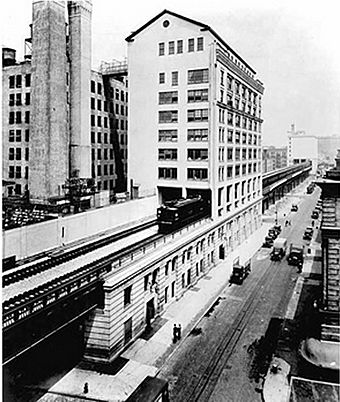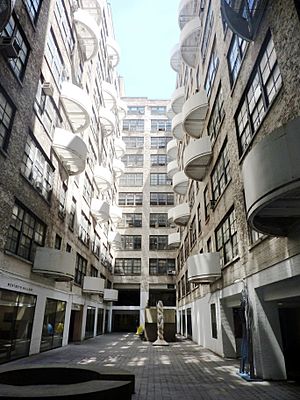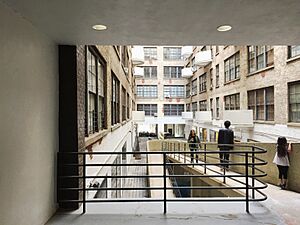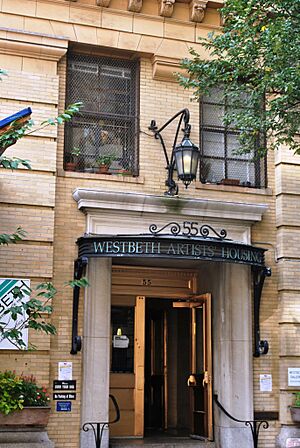Westbeth Artists Community facts for kids
|
Westbeth
|
|

The Bell Laboratories Building, which now houses Westbeth, seen in 1936
|
|
| Area | .9 acres (0.36 ha) |
|---|---|
| Part of | Bell Telephone Laboratories (ID75001202) |
| NRHP reference No. | 09001085 |
Quick facts for kids Significant dates |
|
| Added to NRHP | December 8, 2009 |
| Designated NHL | May 15, 1975 (455–463 West Street only) |
Westbeth Artists Housing is a special place in New York City where artists can find affordable homes and workspaces. It's a non-profit complex, meaning it's not run to make money, but to help artists. Westbeth is located in the West Village neighborhood of Manhattan. Its name comes from the streets that surround it: West Street and Bethune Street.
This unique complex used to be the headquarters for Bell Telephone Laboratories from 1898 to 1966. Bell Labs was a famous research center. After Bell Labs moved out, the buildings were changed into homes and studios for artists between 1968 and 1970. A famous architect named Richard Meier helped design this change. Westbeth is the largest project of its kind in the world, helping artists with lower or middle incomes. It received help from the J.M. Kaplan Fund and money from the United States government.
Westbeth is managed by a non-profit group called Westbeth Corp. Housing Development Fund Corp. Inc. This group has volunteers who help run the complex. Many people who live at Westbeth have been there for a long time. In 2009, about 60% of the residents were over 60 years old. Because of this, Westbeth has a social worker on site to help residents. Children of tenants can sometimes take over their parents' apartments, which helps create a community with different generations. The waiting list for an apartment was closed for many years but reopened on March 18, 2019.
Contents
History of Westbeth Artists Housing
Westbeth is a great example of "adaptive reuse." This means taking old buildings that had one purpose and changing them to be used for something new. In this case, old industrial buildings became homes and studios for artists. Westbeth is made up of 13 buildings in Manhattan's West Village.
From Bell Labs to Artist Homes
The buildings were originally part of the Bell Laboratories Building. This was one of the most important industrial research centers in the world. Many amazing inventions were created here, including:
- The vacuum tube
- The condenser microphone
- An early version of television
- The transistor
Bell Labs moved out in the mid-1960s, and the buildings were empty for a while. Then, a developer named Dixon Bain, with help from the J.M. Kaplan Fund and the National Council for the Arts (now the National Endowment for the Arts), started to change the complex. They created 384 living and studio spaces for artists of all kinds. This project was one of the first big jobs for architect Richard Meier. Westbeth officially opened in 1970.
Who Can Live at Westbeth?
Artists from all different fields, like painting, music, and dance, can apply to live at Westbeth. A committee of artists who already live there reviews the applications. People must also meet certain income rules. In 2014, residents paid about $800 a month for rent, which included electricity. This was much less than what similar places would cost in the area.
Spaces for Arts and Culture
Besides homes, Westbeth also has many spaces for cultural activities. There are commercial spaces, performance areas, and studios for rehearsals and artists. Many important cultural groups are based at Westbeth, such as:
- The New School for Drama
- The LAByrinth Theater Company
- The Martha Graham Center of Contemporary Dance
- Congregation Beit Simchat Torah, which is the first LGBT synagogue in New York and the largest in the world.
The space now used by The New School was once an off-Broadway theater.
Recognizing Westbeth's Importance
Westbeth was added to the National Register of Historic Places on December 8, 2009. This means it's recognized as an important historic site in the United States. The Greenwich Village Society for Historic Preservation helped make this happen. They even interviewed people like architect Richard Meier and choreographer Merce Cunningham to gather information.
Later, on October 25, 2011, Westbeth was also named a landmark by the New York City Landmarks Preservation Commission. This gives it special protection within the city.
In 2024, a community art space opened at Westbeth. A big renovation project, costing $84 million, was finished in February 2025. This renovation made 32 more apartments available.
Organizations at Westbeth
The Westbeth Artists' Residents Council (WARC) is like a tenants' association for the artists living there. They are elected by the residents. This council organizes cultural events for the public, such as readings, performances, and film screenings. They use the Westbeth Community Performance Space and run the Westbeth Art Gallery, which shows art from both residents and other artists. The council also has a website that features the work of its artist-residents and shares information about events.
The Westbeth Beautification Committee is a group of volunteers from Westbeth. Since 1984, they have held an annual Westbeth Flea Market. This market raises money for projects that help Westbeth, the local community, and charities.
Notable People at Westbeth
Many famous artists, musicians, and performers have lived at Westbeth Artists Housing. Some of them include:
- Diane Arbus – a photographer who passed away in 1971.
- Robert De Niro Sr. – a painter and father of the actor Robert De Niro.
- Vin Diesel – a well-known actor.
- Merce Cunningham – a famous choreographer and dancer. His studio was at Westbeth for over 40 years.
- Edward Field – a poet who has lived at Westbeth for a very long time and is considered one of its important figures.
One of the first feminist theater groups in the country, the Westbeth Playwrights Feminist Collective, started here.
Several films have been made about Westbeth and its residents:
- Growing Up At Westbeth is a film that shows photos, videos, and interviews with children who grew up in the complex. It was shown at Westbeth's 40th Anniversary Celebration in 2010.
- Harry's Gift, A New York Story (2015) is a documentary about Harry Schunk, a photographer and long-time Westbeth resident.
- Winter at Westbeth (2016) follows one year in the life of the building and focuses on three long-term residents: filmmaker Edith Stephen, poet Ilsa Gilbert, and dancer Dudley Williams. This film has been shown at many festivals and even at the US Library of Congress.
Some notable artists who currently live or have lived at Westbeth include:
- Peter Bernstein – a jazz guitarist
- Edward Field – a poet
- Valerie Ghent – a musician, singer, and songwriter
- David Greenspan – an actor, playwright, and director
- Nasheet Waits – a drummer
See also
 In Spanish: Westbeth Artists Community para niños
In Spanish: Westbeth Artists Community para niños
- Paul Abels






